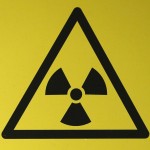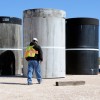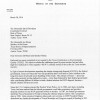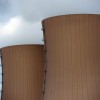Background
Does Texas Have Any Radioactive Waste?
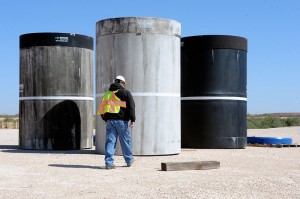
David Bowser
John Ward, operations project task manager at Waste Control Specialists' facility near Andrews, Texas, walks over to inspect concrete canisters that will house drums of nuclear waste.
It most certainly does. There are generally two types of radioactive waste: low-level and high-level.
Low-level radioactive waste tends to be from items not associated with nuclear power generation.”This waste typically consists of contaminated protective shoe covers and clothing, wiping rags, mops, filters, reactor water treatment residues, equipments and tools, luminous dials, medical tubes, swabs, injection needles, syringes, and laboratory animal carcasses and tissues,” according to the U.S. Nuclear Regulatory Commission.
Waste Control Specialists owns a treatment, storage and disposal facility for low-level radioactive waste in Andrews, Texas, and could be a top bidder to manage any incoming high-level waste. It is one of only four low-level radioactive waste facilities in the United States.
Nuclear power plants in Texas also have high-level radioactive waste, which they currently have to store on-site. Texas Governor Rick Perry and other state leaders are now pushing for the state to permit a facility that could store or dispose of high-level radioactive waste.
What is High-Level Radioactive Waste Exactly?
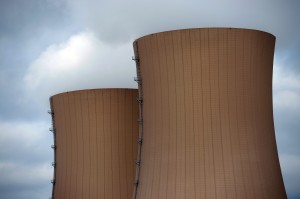
Frank Map DPA/Landov
Cooling towers of a nuclear power plant in Grohnde, Germany. An interim charge for the Texas legislature could change Texas' management of nuclear waste.
Simply put, high-level radioactive waste is spent fuel from commercial nuclear power plants. It has a much longer half-life and is far more concentrated than low-level waste—medical equipment or contaminated clothes and tools used in nuclear power plants, for example—so it needs to be handled in a very careful, specific way.
“Whenever you’re giving off radiation, that radiation will deposit somewhere and create a little bit of heat. If you are producing heat, you have to remove the heat,” Steven Biegalski, Director of the Nuclear Engineering Teaching Laboratory at the University of Texas, says. “If you don’t remove even just a little bit of heat, temperatures can rise and then there’s issues. It’s not that these issues are insurmountable … when you’re doing it, you’re looking at thousands and thousands of years for the time we would expect things to be contained in a high-level waste repository.”
One widely-accepted solution for dealing with the waste involves burying it deep underground or recyling it—but putting it on a rocket and sending it into the sun has also been tossed around.
The Texas state legislature is currently looking into two types of high-level radioactive waste storage in Texas: a central interim storage site and a permanent, long-term national repository. A bill to allow high-level radioactive waste disposal and storage in Texas failed to pass during the last legislative session.
“The big fear we have about a long-term storage is that a private company will come in, make all the gain, and leave Texas with all the pain of having to maintain this site for millennia,” Tom “Smitty” Smith, director of Public Citizen’s Texas office, says.
Why Texas and Why Now?
An ideal site for storing high-level radioactive waste, according to Biegalski, would need to be dry, geologically stable, and away from dense population centers, making areas like western Texas and much of Nevada perfect candidates. But there is currently no plan for a national repository.
In 2002, Congress approved a site within Yucca Mountain, in Nevada, to be a long-term storage site, but the Obama Administration ended funding for the site in 2010 after years of pressure from state officials and Senate Majority Leader Harry Reid. There was no backup plan, yet nuclear power plants have still been paying a tax to fund a permanent storage site.
According to Dale Klein, Associate Director of the University of Texas at Austin’s Energy Institute and former Chairman of the U.S. Nuclear Regulatory Commission, utility companies have put almost 30 billion dollars into that fund since 1982. Though companies are still paying—and passing the costs off to consumers—recent lawsuits have challenged the legality of collecting money without having a proposed site.
“The courts have recently ruled that the Department of Energy cannot continue to charge [the tax] because they have no plan,” Klein said. “It hasn’t been finalized, but the courts directed the Department of Energy not to collect that fee anymore.”
Taxes aside, power plants can safely store their high-level radioactive waste on-site for the time being, in pools and steel casks. Klein estimated that this is viable and safe for about another 100 to 200 years. But many states don’t want that waste in their own backyards and are willing to pay for someone else to take care of it.
“They technically can handle it on site, and it’s not so difficult that it has prevented utilities from making decisions to build new nuclear power plants,” Biegalski says, “But on some level it’s frustrating that this problem is being kicked down the road when the U.S. government said they’d tackle the problem and that they’d solve it, but yet they’re not.”
This is where Texas could step in.
Why is it So Controversial?
Approving an interim storage facility for high-level radioactive waste would be relatively painless, Klein says, but a national repository to bury it underground for tens of thousands of years will take much longer and be far more controversial.
“In general, what will happen is that the public will probably not get as emotionally engaged on a central interim storage, because that’s a temporary process. But the permanent geological storage is one that typically brings out a lot of emotions,” he says.
Klein put the likelihood of central interim storage in Texas as high, while a permanent repository isn’t as likely.
The directive for the legislature to study the issue may have been influenced by private Texas companies looking to take economic advantage of a national problem. Waste Control Specialists owns a treatment, storage and disposal facility for low-level radioactive waste in Andrews, Texas, and could be a top bidder to manage any incoming high-level waste.
That existing radioactive waste facility took ten years to approve and build, resulted in three resignations from the state’s environmental agency, and is the subject of an alleged cover-up. It’s in rural Andrews County, not far from the New Mexico border. The site began accepting its first shipments of waste in mid-2013.
The late Dallas billionaire Harold Simmons owned the disposal site. Simmons had lobbied for state approval of the site for years, and ultimately got it. “He’s been working that play for years,” said Andrew Wheat, research director of the left-leaning watchdog group Texans for Public Justice, after the last legislative session. “Every session, he’s back to the legislature and the Governor to ask for more. And every session they give him more.”
The company had asked the state to increase the levels of radioactivity and amounts of waste they can dump at the site, a measure the legislature considered but did not approve. The company also wanted to limit any contesting of the site to Texas residents. (The site sits near the New Mexico border.)
Simmons gave $3.4 million to state candidates during the 2012 election; lobbying for Waste Control Specialists totaled somewhere between $675,000 and $1.2 million during the 2013 legislative session.
The majority of storage space at the 1,300 acre site is designated for members of the Texas Low Level Radioactive Waste Disposal Compact Commission, which only includes Texas and Vermont. The crater-like disposal site is the only one in the nation built to store all three classes of low level waste.
So Couldn’t We Just Put High-Level Radioactive Waste There?
Awarding Waste Control Specialists a contract for high-level radioactive waste disposal would be a huge mistake, Smith of Public Citizen says.
“It’s all risk and very little reward for the state of Texas. High-level radioactive waste is extremely dangerous and has been rejected by every state that has looked at it because of the high likelihood that if it comes in contact with water or other chemicals, you could have an out-of-control reaction,” he says.
“The current low-level radioactive waste site is adjacent to an aquifer that serves eight states, and there is water in the monitoring wells around the storage and disposal facilities, which we can’t get dry after years of pumping.”
Smith acknowledges, however, that there could be sites in Texas or other states suitable for a national repository, but they haven’t been evaluated yet.
“There may well be some other sites that are better for long-term waste than Texas, and that’s a decision that should be made, based on science, at the national level, rather than made by a a committee in the Texas legislature,” he says.
